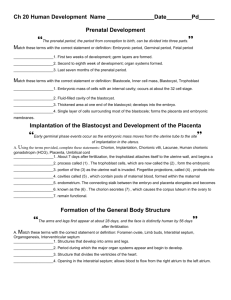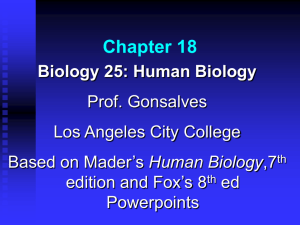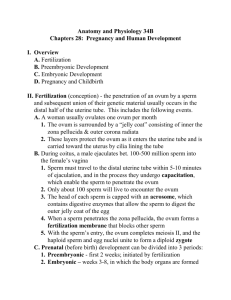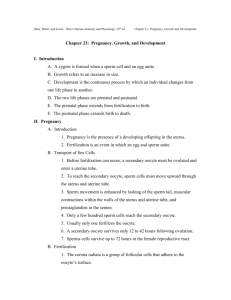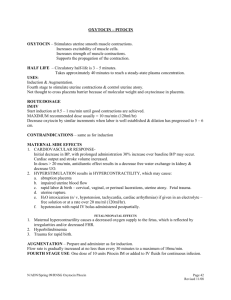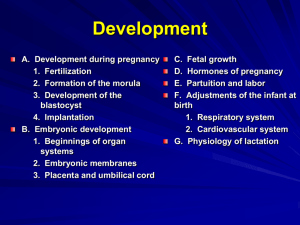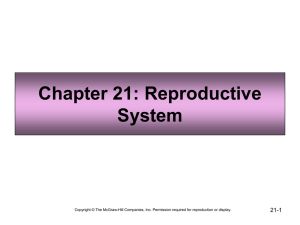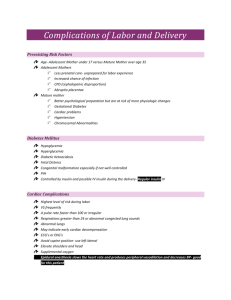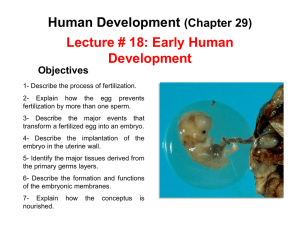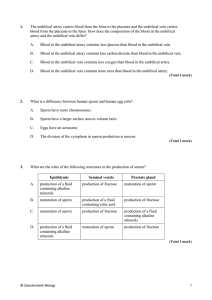Biology 112
advertisement
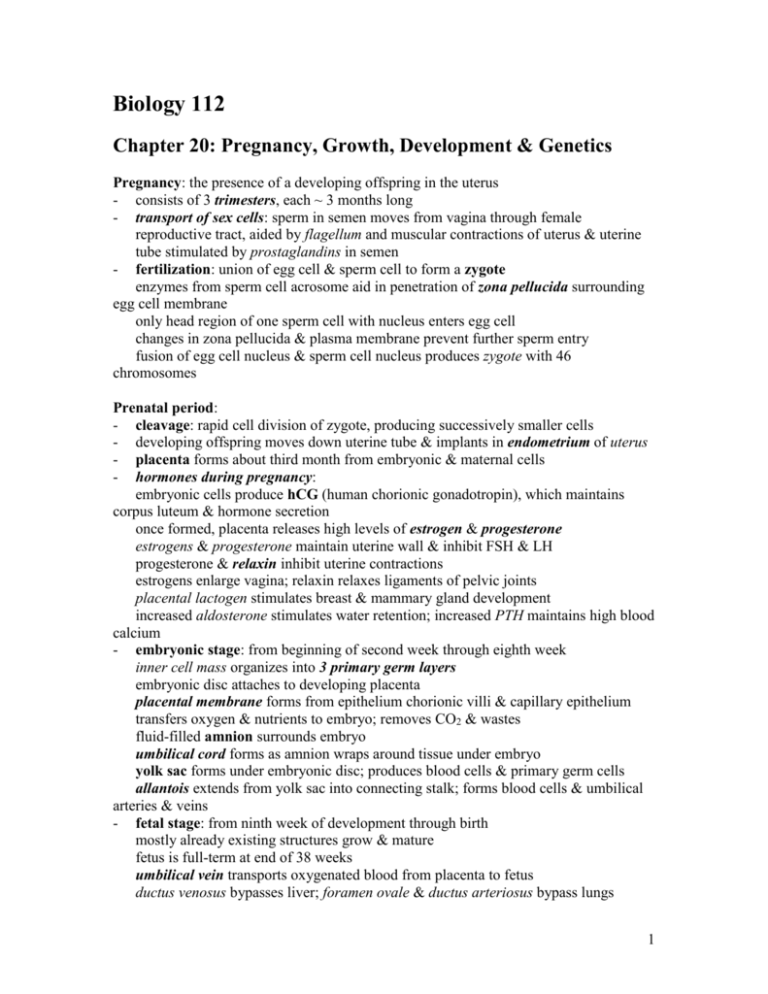
Biology 112 Chapter 20: Pregnancy, Growth, Development & Genetics Pregnancy: the presence of a developing offspring in the uterus - consists of 3 trimesters, each ~ 3 months long - transport of sex cells: sperm in semen moves from vagina through female reproductive tract, aided by flagellum and muscular contractions of uterus & uterine tube stimulated by prostaglandins in semen - fertilization: union of egg cell & sperm cell to form a zygote enzymes from sperm cell acrosome aid in penetration of zona pellucida surrounding egg cell membrane only head region of one sperm cell with nucleus enters egg cell changes in zona pellucida & plasma membrane prevent further sperm entry fusion of egg cell nucleus & sperm cell nucleus produces zygote with 46 chromosomes Prenatal period: - cleavage: rapid cell division of zygote, producing successively smaller cells - developing offspring moves down uterine tube & implants in endometrium of uterus - placenta forms about third month from embryonic & maternal cells - hormones during pregnancy: embryonic cells produce hCG (human chorionic gonadotropin), which maintains corpus luteum & hormone secretion once formed, placenta releases high levels of estrogen & progesterone estrogens & progesterone maintain uterine wall & inhibit FSH & LH progesterone & relaxin inhibit uterine contractions estrogens enlarge vagina; relaxin relaxes ligaments of pelvic joints placental lactogen stimulates breast & mammary gland development increased aldosterone stimulates water retention; increased PTH maintains high blood calcium - embryonic stage: from beginning of second week through eighth week inner cell mass organizes into 3 primary germ layers embryonic disc attaches to developing placenta placental membrane forms from epithelium chorionic villi & capillary epithelium transfers oxygen & nutrients to embryo; removes CO2 & wastes fluid-filled amnion surrounds embryo umbilical cord forms as amnion wraps around tissue under embryo yolk sac forms under embryonic disc; produces blood cells & primary germ cells allantois extends from yolk sac into connecting stalk; forms blood cells & umbilical arteries & veins - fetal stage: from ninth week of development through birth mostly already existing structures grow & mature fetus is full-term at end of 38 weeks umbilical vein transports oxygenated blood from placenta to fetus ductus venosus bypasses liver; foramen ovale & ductus arteriosus bypass lungs 1 umbilical arteries carry mostly deoxygenated blood to placenta through internal iliac arteries fetal blood is enriched with oxygen; fetal hemoglobin has greater oxygen affinity - childbirth placental progesterone inhibits uterine contractions during pregnancy decreasing progesterone near end of third trimester & release of prostaglandin initiate birth process oxytocin from posterior pituitary stimulates uterine contractions & labor following birth, placental tissues are expelled Postnatal period - following childbirth, placental hormones decline, releasing block to prolactin - prolactin stimulates milk secretion - suckling causes oxytocin release, which stimulates milk ejection - neonatal period: from birth to end of first 4 weeks newborn begins to breathe; first breath must be powerful to expand lungs also begins to obtain nutrients, excrete waste & regulate body temperature newborn depends largely on stored fat for energy (liver still immature) homeostatic mechanisms also immature liver & lung circulatory bypasses constrict & close Genetics - chromosomes & genes are in homologous pairs (one from sperm & one from egg) - karyotypes show all 46 chromosomes in pairs - 22 pairs of autosomes & one pair of sex chromosomes (XX in females; XY in males) - homozygous: 2 identical alleles for a trait - heterozygous: 2 different alleles for a trait - genotype: alleles present (genetic information) for a trait - phenotype: physical appearance for a trait - dominant alleles mask expression of recessive alleles - polygenetic inheritance: traits controlled by more than one gene - Punnett squares & pedigrees depict gene transmission in families 2
